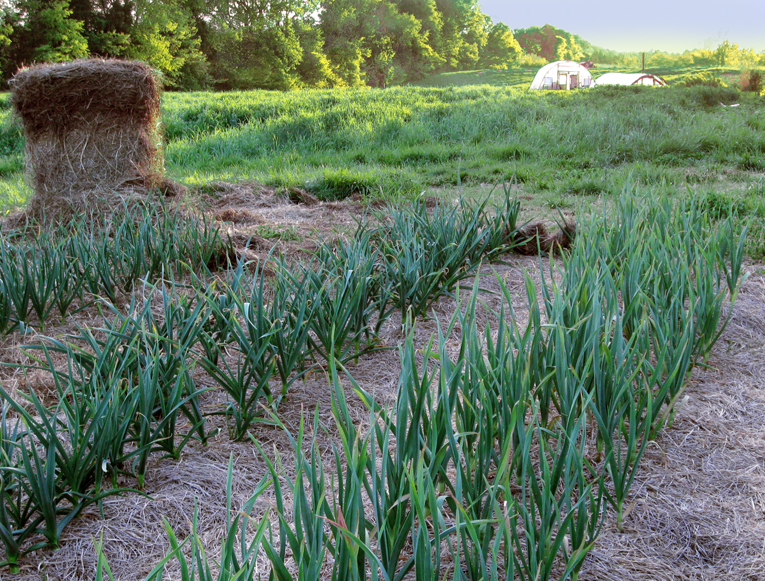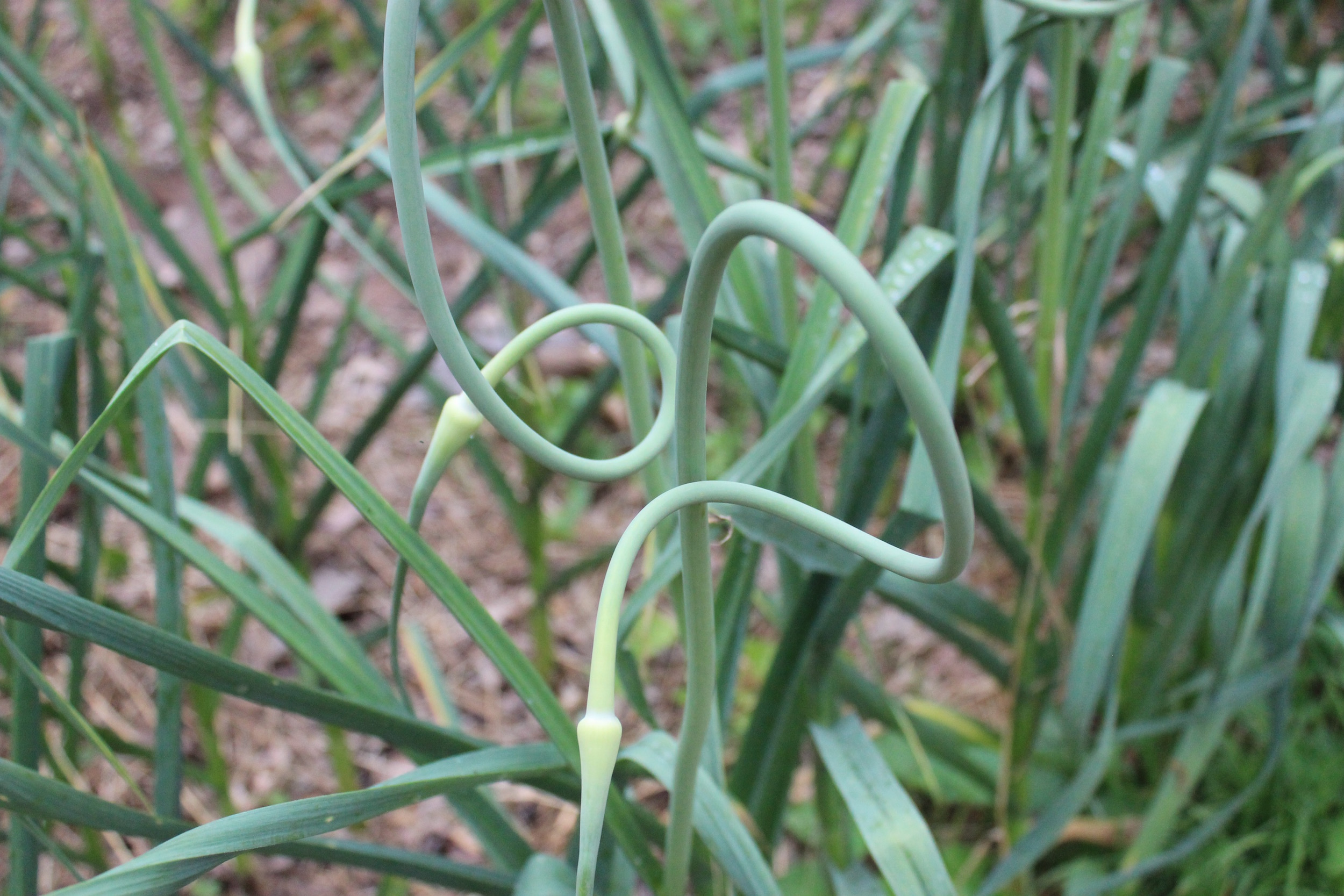Garlic: Raised Bed vs. The Human Bed

Every vegetable patch needs a garlic section! Garlic provides tons of flavor with little effort. It’s a great option for beginners because it’s easy to grow, takes up little space, stores well, and is easy to maintain year after year. Once you buy garlic, you won’t need to buy it again. Raised beds are often the preferred option for growing garlic, but they are not your only option. In this post, we’ll dig into the soil requirements of garlic and why you may or may not want to install raised beds.
Soil Requirements for Garlic
Soil structure is the most important factor to consider when growing garlic. Roots need as much air as they need water. Garlic works best, it makes the biggest one bulbs, in open, well-lit soil. Sandy loam is fine, but few people are blessed with soil like this.
If you are working with heavy clay or sand, the best thing to do is to use more organic matter in your beds. Add compost, old compost, peat moss, rotted sawdust, or a combination. Growing a cover crop in your bed before planting garlic is another great way to build soil structure.
If you haven’t already, a soil test can be helpful for garlic and all your other plants. Garlic and onions prefer a neutral pH between 6.5 to 7.0. Soil outside this range that is too acidic or too alkaline will stunt garlic growth and cause late ripening.
See more about soil amendments and nutrient deficiency symptoms in our guide A complete guide to growing garlic.
Raised beds of Garlic Pros and Cons
Creating raised beds is one solution to quickly provide good garlic soil. There are a few pros and cons to consider before you get started.
Raised Beds for Garlic Beauty
- Raised beds quickly provide excellent, deep, loose soil for garlic.
- They warm up quickly in the spring.
- Raised beds usually have good drainage.
- Raised beds are generally easier to maintain and can help reduce weed pressure.
Raised beds for Garlic Cons
- To deliver in the middle soil, compost, and/or building materials can be expensive.
- Raised beds may dry out quickly and require watering in the summer.
- Eventually, raised beds may need to be repaired or replaced.
Traditional Beds Pros and Cons of Garlic
It is also acceptable to plant garlic in the soil of a common garden bed. Like raised beds, this method comes with its pros and cons.
Traditional Beds of Garlic Specialists
- There is no construction required, and you will not have to prepare or maintain raised beds.
- Traditional beds are easy to cultivate.
- Traditional beds are easy to install in large sprinkler or irrigation systems.
Traditional Beds of Garlic
- They may have dense clay soils or poor sandy soils that may take time to amend.
- Traditional beds tend to have poor drainage and may remain wet in the spring.
- Traditional beds may be susceptible to erosion and weed stress.
How to Design Raised Garlic Beds
Once you’ve decided that raised beds are right for you, it’s time to start planning. In general, it’s a good idea to put things down on paper before you start building.
Ideally, raised beds should be at least 12 inches deep. Their length doesn’t matter, although you may want to break one long bed into several smaller ones to create work paths. Its width is also a personal choice, but you should be able to easily reach the middle of the bed to grow, plant, and harvest without standing on it. Many people make beds 3 to 4 wide for this reason.
You also want to think about the location of your raised beds. Make sure they get plenty of sunlight and are close to your garden hose or irrigation system.
If you’re building a lot of raised beds or placing them next to other structures, it’s also a good idea to leave paths around your beds at least wide enough to fit a wheelbarrow.
Remember that plant roots will grow deeper than your raised bed. Do not place the raised bed in any area that has been contaminated with chemicals.
Once you have a plan, you can frame your raised beds. You can make raised beds out of logs, non-decomposing wood such as black locust or cedar, stones, bricks, or blocks. Avoid using tires, pressure logs, or any materials that may introduce chemicals into your produce beds. Depending on the materials you use, the corners can be held together with studs, duct tape, or screws.
Fill your beds with quality soil and compost or freshly composted compost. You will need more things than you think will be stable. You should fill at least 12 inches deep with compost or good soil. Adding compost to the bed every year is also a good idea.
How to Design Traditional Garlic Beds
Although some gardeners prefer raised beds, many gardeners still find great success growing garlic in the garden. If you decide this is the best option for you, there are a few things to consider when preparing your beds.
Garlic hates having soft feet. If you have the space to work, always find beds of garlic and other alliums in your highest or highest-draining areas. Low spots that remain wet throughout spring and early summer will result in poor yields.
Prepare your beds by adding lots of organic matter or cutting the cover early or by working in compost, peat moss, old rotted sawdust, or old manure. As mentioned above, a soil test and any necessary amendments are also a good idea if you need to change the pH or increase the fertility.
Many people choose to till new beds, but you can also loosen the soil with a wide fork or garden fork for a no-till option. This is also a good choice for farmers working on small plots. Forks allow you to lift and loosen the soil without turning it.

Tips for Growing Garlic
Garlic is usually an easy keeper, but there are a few things to keep in mind that can improve your harvest.
- Water garlic regularly if you don’t have a lot of rain during its growing season in spring and summer.
- Garlic does not compete well with weeds. Keep your plot growing well to find out the greatest of all bulbs.
- Choose the right type of garlic your garden and climate zone.
- Plant your garlic at the proper depth and spacing.
- Mulch garlic well with old leaves, grass, or hay.
- If you grow hardneck or Asiatic garlic, remove the scapes when they eat the best bulb production stage.
- Use a garden fork to gently harvest the bulbs and cure and store them properly.
Source link



